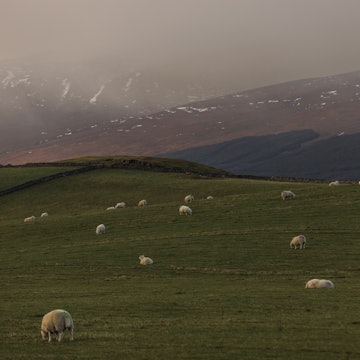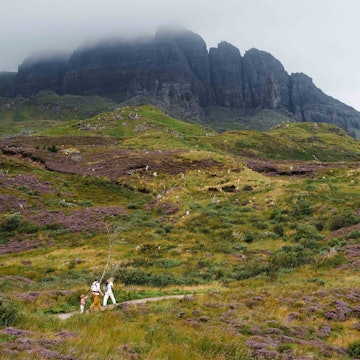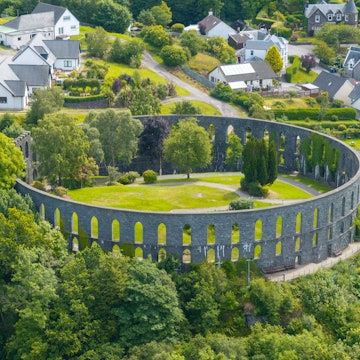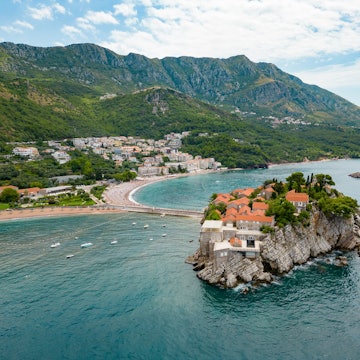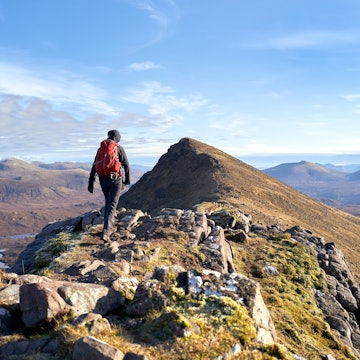

Hiking the Quiraing is just one adventure on the Isle of Skye. Lunghammer/Shutterstock
The scenery on the Isle of Skye is the stuff of pure enchantment, with cozy fishing and crofting villages tucked in among crashing cliff-edge waterfalls, emerald-green river valleys, glacier-sculpted hills and sharp-toothed mountain peaks – a testament to the many Ice Ages the island has endured. Add in famous-name whisky, oodles of Highlands history and spectacular hiking trails and this might be the Scotland you’ve always imagined.
Aesthetics aside, Skye is steeped in stories, from the real-life history of the feuding MacDonald and MacLeod clans, Viking raids and Bonnie Prince Charlie’s escape here after the Battle of Culloden, to the blurred lines of fairies, folklore and the slain giant reputedly preserved as the Old Man of Storr. Sure, it gets busy here, but few places in Scotland transport you so effortlessly to a world of Highland myths and legends.
Many visitors drive around the classic ticklist of high-footfall sights, but we recommend lacing up your hiking boots and setting out on foot to explore. In between village stops and distillery tours, climb between the eroded peaks of the Quiraing, wander to the iconic lighthouse at Neist Point or attempt the unforgiving ridges of the Black Cuillin mountains.
We promise you won’t run out of things to do on the Isle of Skye – here are our top suggestions.

1. Explore Portree, Skye’s pocket-sized capital
Not many capitals are small enough to walk around in an afternoon, but Skye’s biggest settlement – a mighty metropolis of 2300 – is well worth a stop. Grab a takeaway lunch from The Chippy on Quay Brae, then eat it as you stroll along the row of pretty, pastel-shaded houses lining Portree Harbour.
Next, walk up to the Skye Gathering Hall, home to a popular little thrift market (closed on Mondays), then follow the unpaved footpath leading up to the hummock known as the Lump – it’s a short but steep climb, and you’ll be rewarded with panoramic views of the surrounding hills.
Take the path down the opposite side of the hill to Bayfield Rd and follow it past the visitor centre and across the road to Somerled Square. This is the heart of the town, enclosed by charming little cafes and browse-worthy boutiques.
From here, walk northeast to the Cuillin Hills Hotel, where signposts mark the start of the Scorrybreac Circuit. This relatively gentle 1.9-mile coastal loop offers uplifting views back over Portree Bay, before you head back into town for dinner.
Planning tip: A walk is a great way to build up an appetite before you sample Portree’s intriguing restaurant menus. Book a table at the excellent, upscale Scorrybreac restaurant for delicious Scottish treats such as Dunvegan venison with smoked cauliflower.
2. Hike up the Quiraing
Looming high above Skye’s Trotternish Peninsula, the Quiraing offers some of the island’s most hauntingly attractive landscapes, and some of its most rewarding hikes. The curious name comes from the Old Norse term kví rand (round fold), referring to the high plateau used for grazing livestock in the days when Viking raiders menaced this stretch of the Scottish coast.
Start early with a winding drive up from Portree to the Quiraing car park, then follow the well-trodden trail up into this unique landslip landscape. First, head for the jagged rocks known as the Prison because of their resemblance to a medieval fortress (at least from some angles). Beware of slippery rocks as you cross the stream and climb the scree slope up to the pinnacle.
From here, you can gaze across to the Needle, a 37m-high (121ft) column of basalt rock that sticks out of the green landscape like a craggy thumb. Next, follow the cliff-hugging path as it winds down and back up to the Table – this grassy plateau was the place local farmers came to hide their cattle during frequent Viking raids.
In case it looks familiar, the Quiraing has stood in as “medieval Scotland” in many movies, from Stardust (2007) and Macbeth (2015) to The BFG (2016). Take time to soak up the panoramic views of Trotternish and the nearby islands of Rona and Raasay before ending the walk back where you started.
Planning tip: The Quiraing can get busy, particularly in summer, so visit in spring or fall for a quieter experience. If you can only come in high season, aim to reach the car park early in the morning to secure a spot.

3. Discover Skye’s best whisky
For the better part of two centuries, Talisker was Skye’s only legal whisky distillery, founded in 1830 on the island’s rugged west coast. The house whisky grew to become one of the world’s most popular single malts and the pretty, white-walled Talisker distillery is open to visitors on tasting tours that allow you to sample its smoky, salty classic whiskies and variations matured in sherry and port casks.
Today, Talisker can no longer claim this corner of Scotland to itself. Take a walk along the sands of Talisker Bay for some sobering sea air, then travel south to the Sleat peninsula to visit the Torabhaig Distillery, where you can sit in a courtyard flanked by old stone farmhouses, to savor its lightly peated single malt.
Planning tip: If you’re the designated driver, you’ll need to settle for just the smells as you tour the distilleries; ask for a “drivers’ dram” to take away and enjoy later when you’re parked up for the night.
4. Experience Skye from the water
The staggering landscapes of Skye make it tempting to keep your feet planted on terra firma, but those who head out to sea get to experience the island from a whole new perspective. Wildlife trips from Portree offer an excellent introduction to Skye’s coastal landscapes and fauna.
Basking idly on the rocks, the silvery grey seals of Rona seem unconcerned by the boats full of wildlife enthusiasts that glide by. The island hosts one of the largest grey seal colonies in Britain, and sightings are all but guaranteed – though most will also be hoping to spot the fins of dolphins and minke whales, and swooping white-tailed sea eagles.
As well as the Rona boat trips offered by the likes of Seaflower Skye, you can get closer to the water (and wildlife) by kayak – Sea to Skye Xperience offers taster courses departing from Broadford. Remember to look back regularly at the Skye shoreline for stunning views of the 719m (2359ft) Old Man of Storr and the Cuillin Hills.
Detour: Prefer to be in the water rather than on it? Join a multiday diving expedition with Dive & Sea the Hebrides to explore some of the incredible marine life, reefs and wrecks that surround the island.

5. Wild swim in the Fairy Pools
If wild swimming in Scotland is only for the brave, wild swimming on the Isle of Skye is only for the legendary. After all, this is one of the wettest and windiest corners of the country. Yet every day, visitors to the Fairy Pools near Glenbrittle set eyes on these crystal-clear waters, tinkling cascades and lush green vegetation, then strip down and plunge in.
For an even more rewarding pool experience, follow the throngs hiking from the car park to the Fairy Pools and continue to climb, to discover a collection of clear, deep and (almost certainly) unoccupied pools just waiting for you to dive in.
Planning tip: Fairies are a big part of Skye culture. Check out the Fairy Glen on Trotternish, the Fairy Bridge on the road up to Stein, and the Fairy Flag at Dunvegan Castle & Gardens – associated with the fairy folk but more likely to have been brought back from the Middle East during the Crusades.
6. Wander the Sleat Peninsula
In the south of Skye, the Sleat Peninsula is well worth a visit, with its headline attraction being the Armadale Castle, Gardens & Museum, a three-in-one sight comprising the romantic ruins of a 17th-century castle, a sprawling estate full of colorful flowers and knockout views, and an excellent museum about Clan MacDonald, known as the Lords of the Isles – arch rivals of Clan MacLeod of Dunvegan.
There’s plenty more to see, from the sandy beach at Rubha Shlèite to the Torabhaig Distillery, and the peninsula offers impressive views toward loftier parts of Skye. Take the steep and twisting minor road that loops through Tarskavaig and Tokavaig for stunning views of the Isle of Rum, the Cuillin Hills and Bla Bheinn.
Planning tip: If you’re looking for a decadent stay on Skye, Sleat has some of the island’s most luxurious hotels, from the lavish lochside Kinloch Lodge to the beautiful boutique hideaway that is the Duisdale House Hotel.

7. Cycle Skye’s wild northwest
Stretching out of Skye’s northwest coast like the claws of a giant crab, the twin peninsulas of Waternish and Duirnish offer a mix of the well-trodden and the out-of-the-way, and it’s a great area to explore by bike. Start your one-day bike tour at Neist Point, west of Portree. One of Skye’s most famous sights, the elegant, Stephenson-built Neist Point Lighthouse, sits here in a humbling location on a rugged cliff jutting out into the sea.
From Neist Point, hop on your bike and follow the road through Glendale, before skirting along Loch Dunvegan. If your budget allows, stop for a fine-dining lunch at the superb Three Chimneys at Colbost. Otherwise, soothe your saddle sores with a stroll around Dunvegan Castle & Gardens – the official seat of Clan MacLeod (although Eilean Donan on the mainland was used as a stand-in in the cult movie Highlander (1986) which is set for a Henry Cavill remake in 2025).
Next, continue east to the Fairy Bridge, guarding the gateway to Waternish. As you cycle northwards beyond Stein, things get remote quickly. At the medieval Trumpan Church, park your bike and continue on foot – a muddy, 8.5-mile hike will bring you to Waternish Point and the handsome Waternish Lighthouse, gazing north toward the Isle of Harris in the Outer Hebrides. Some days, you won’t see another soul here, with just a bay full of whales and dolphins for company.
8. Explore Skye’s craft creativity
The island is alive with craft workshops and producers of unique mementoes, recalling the cottage industries of Skye’s crofting days. Start a craft tour in Portree’s Isle of Skye Soap Co, producing soaps inspired by the island’s landscapes and flora, then head over to Broadford for divinely scented handmade natural candles at the Isle of Skye Candle Co.
At island shops, look out for the work of Katie Tunn, a marine conservationist and painter whose work is inspired by Skye’s seas and starry skies. Quirky ceramics representing local landscapes are sold at the Edinbane Pottery pottery studio on the road to Dunvegan, while nearby Skye Silver specializes in distinctive Celtic-themed gold and silver jewellery.
Cozy knitwear and other natural-fibre clothing are the offerings at Ragamuffin, near the jetty for the CalMac ferry from Armadale to Mallaig. Over at Waternish, Skyeskyns sells luxurious sheepskin rugs, throws, clothing and footwear, directly from the tannery.

9. Take a road trip to Elgol
As you turn out of Broadford onto the B8083, it doesn’t feel like you are about to embark on one of the most dazzling drives in Scotland, but you’ll soon spot round-topped Beinn na Caillich rising behind the Broadford Hotel and emerge into a classic Highlands landscape.
The next 30 minutes of driving will be a blur of barely believable vistas. First, there’s the picturesque valley of Strath Suardal. Then there’s the Insta-worthy ruins of a roofless church overlooking Loch Cill Chriosd. And then, most impressive of all, are the views of the solemn Blà Bheinn mountain across Loch Slapin (stop at Amy’s Place for a cup of tea to soak them in).
As you approach Elgol, traditional crofts lead the way down to the town’s pier, which has perhaps the best vista of all, with the Cuillin Hills jutting skywards across the water. Strong hikers may fancy going for a closer look, with a challenging hike of around 10 miles along the shore to Loch Coruisk at the foot of the mountains. Less capable walkers can visit the loch on a boat trip with Misty Isle Boat Trips.
10. Scramble up the Cuillin Hills
Arguably Britain’s most spectacular mountain range, the Cuillin Hills take their name from the Old Norse term kjöllen, meaning “keel-shaped.” While the highest summit, Sgurr Alasdair, is only 993m (3258ft) high, the peaks are near-alpine in character, with knife-edge ridges, jagged pinnacles, scree-filled gullies and sheer expanses of naked rock.
While they are a paradise for experienced mountaineers, the higher reaches of the Cuillin are off limits to the majority of hikers. The good news is that there are plenty of good low-level hikes within the ability of most walkers, accessible from Sligachan to the north or Glenbrittle to the south.
One of the best starter hikes is the steep climb from Glenbrittle campsite to Coire Lagan, a six-mile round trip. The impressive upper corrie contains a lochan for bathing (if you’re feeling ambitious) and the surrounding cliffs are a playground for rock climbers.
Planning tip: For hardcore ascents of the Black Cuillin – the rocky main spine of the Cuillin Hills, comprising 11 Munros (peaks over 914.4m/3000ft) – consider joining a guided multiday hike with Rock N Ridge.
This article was adapted from Lonely Planet’s Scottish Highlands & Islands guidebook, published in June 2025.








